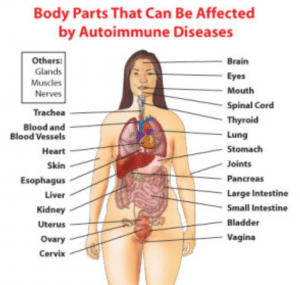The Cryosauna is Used to Treat Auto-Immune Diseases
What are autoimmune diseases?
(From http://womenshealth.gov/publications/our-publications/fact-sheet/autoimmune-diseases.html)
Our bodies have an immune system, which is a complex network of special cells and organs that defends the body from germs and other foreign invaders. At the core of the immune system is the ability to tell the difference between self and nonself: what’s you and what’s foreign.
A flaw can make the body unable to tell the difference between self and nonself. When this happens, the body makes autoantibodies (AW-toh-AN-teye-bah-deez) that attack normal cells by mistake. At the same time special cells called regulatory T cells fail to do their job of keeping the immune system in line. The result is a misguided attack on your own body. This causes the damage we know as autoimmune disease. The body parts that are affected depend on the type of autoimmune disease. There are more than 80 known types.
How Common Are Autoimmune Diseases?
Overall, autoimmune diseases are common, affecting more than 23.5 million Americans. They are a leading cause of death and disability. Yet some autoimmune diseases are rare, while others, such as Hashimoto’s disease, affect many people.
Who Gets Autoimmune Diseases?
Autoimmune diseases can affect anyone. Yet certain people are at greater risk, including:
- Women of childbearing age
— More women than men have autoimmune diseases, which often start during their childbearing years.
- People with a family history
— Some autoimmune diseases run in families, such as lupus and multiple sclerosis. It is also common for different types of autoimmune diseases to affect different members of a single family. Inheriting certain genes can make it more likely to get an autoimmune disease. But a combination of genes and other factors may trigger the disease to start.
- People who are around certain things in the environment
— Certain events or environmental exposures may cause some autoimmune diseases, or make them worse. Sunlight, chemicals called solvents, and viral and bacterial infections are linked to many autoimmune diseases.
- People of certain races or ethnic backgrounds
— Some autoimmune diseases are more common or more severely affect certain groups of people more than others. For instance, type 1 diabetes is more common in white people. Lupus is most severe for AfricanAmerican and Hispanic people.
How Do Cryosauna Treatments Work to Help Autoimmune Conditions
(From:http://www.lifestreammed.com/resources/resources/cryotherapy/wbc_ClinicalRelevanceOf.pdf)
WBC treatments work by subjecting the patient‟s skin to controlled levels of gasiform liquid nitrogen. The treatment is conducted in a device called a cryochamber. Before treatment, the cryochamber is pre-cooled and dried, and the patient is given informed consent. Next, the patient disrobes inside the chamber, keeping on socks to protect their toes. Men also wear regular underwear to protect external genitalia. The floor of the unit elevates allowing the patient‟s head to be outside of the chamber so they can continue to breath room air.
Nitrogen gas is safe to breathe since it makes up roughly 80% of our atmosphere, however in a pure state it displaces oxygen. The patient‟s fingertips are protected by keeping their hands placed on a padded ledge around the top of the chamber.
During a session, bursts of nitrogen are circulated around the chamber, directed away from the patients skin. The bursts serve to maintain the therapeutic temperature. In a typical 3 minute session, 10 second bursts are released with 20-30 second pauses between them. The ambient temperature in the chamber is maintained at -200 to -250°F throughout the course of treatment.
Ideal treatment intensities cause a spontaneous shiver reflex to began just at the end of the session. The cryotherapist is able to adjust certain variables, to achieve a brief shiver reflex without the cold being too intense. These include: amount of pre-cooling, duration of bursts, duration of pause between bursts and the duration of the session.
Those who are older, less physically active and less tolerant of cold, can achieve this response with milder treatments and briefer durations. Those who undergo a series of treatments usually prefer colder treatments as their series progresses.
Immediately after the 2.5 – 3 minute session, the majority of subjects experience marked improvements in pain and joint discomfort and notice measurable reductions in joint edema. Most also experience endorphin releases normally experienced only after intense exercise.
Mechanisms of Action
The genome of modern humans experienced the majority of its evolution over the Pleistocene Epoch. This time period is demarcated by alternating glacial (ice ages) and interglacial (temperate) periods. The majority of time was likely spent in glacial periods, thus engendering many genetic adaptations to cold.
These adaptations are the likely reason that WBC induces homeostatic responses from most of the body‟s regulatory mechanisms.
The initial cold startle response elicits a strong sympathetic nervous system reaction. This causes a dramatic parasympathetic rebound.
The circulatory system undergoes dramatic peripheral vasoconstriction followed by strong rebound vasodilation. This improves peripheral vascular tone while reducing histamine release due to vascular permeability.
The neuromuscular system responds with a decrease in troponin I, creatine kinase and edema.
Positive immune responses include increased white blood cell counts, increased anti-inflammatory cytokines, and reduced pro-inflammatory prostaglandin.
In the endocrine system, WBC triggers an increase in noradrenaline, β-endorphins, adrenocorticotropic hormone(ACTH) and pro-opiomelanocortin (POMC) concentrations.
Are chronic fatigue syndrome and fibromyalgia autoimmune diseases?
Chronic fatigue syndrome (CFS) and fibromyalgia (feye-broh-meye-AL-juh) (FM) are not autoimmune diseases. But they often have symptoms of some autoimmune disease, like being tired all the time and pain.
CFS can cause you to be very tired, have trouble concentrating, feel weak, and have muscle pain. Symptoms of CFS come and go. The cause of CFS is not known.
FM is a disorder in which pain or tenderness is felt in multiple places all over the body. These “tender points” are located on the neck, shoulders, back, hips, arms, and legs and are painful when pressure is applied to them. Other symptoms include fatigue, trouble sleeping, and morning stiffness. FM mainly occurs in women of childbearing age. But children, the elderly, and men are sometimes can also get it. The cause is not known.

